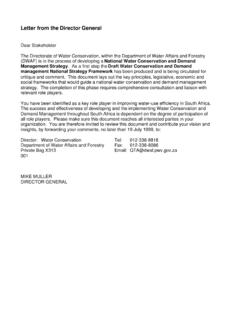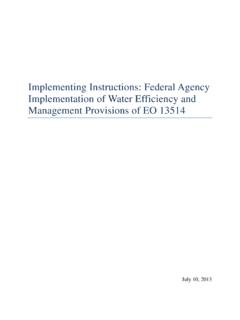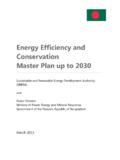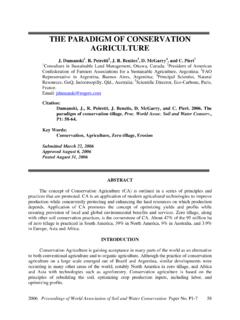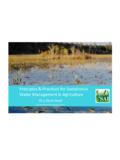Transcription of Water Investigation Zone No. 2
1 Attachment B SAN JOAQUIN COUNTY FLOOD CONTROL & Water conservation DISTRICT Water Investigation Zone No. 2 Fee Analysis Report Submitted to: Department of Public Works San Joaquin County, California Prepared by: HARRIS & ASSOCIATES, INC. 22 Executive Park Irvine, CA 92614 March 10, 2015 SAN JOAQUIN COUNTY FLOOD CONTROL & Water conservation DISTRICT Water Investigation Zone No. 2 Property Fee Analysis Report TABLE OF CONTENTS SECTION I HISTORICAL BACKGROUND AND CURRENT CONDITIONS .. 1 SECTION II COST OF 3 Objective of the Property Fee Analysis Report .. 3 Legal Requirements .. 4 Property Fee Setting Process .. 5 SECTION III SERVICE AREAS & ZONE 2 BUDGET .. 7 Irrigated Land Area .. 7 Developed Land Area .. 7 Apportionment of Cost by Service Area .. 7 Zone 2 Budget .. 8 SECTION IV PROPERTY FEE 9 SECTION V PROPERTY FEE CALCULATION.
2 11 Annual Adjustment to Property Fees .. 11 SECTION VI REFERENCES .. 13 APPENDIX A LISTING OF PROPERTY FEE BY ASSESSOR PARCEL NUMBER .. A-1 APPENDIX B SERVICE AREA MAP .. B-1 SAN JOAQUIN COUNTY FLOOD CONTROL & Water conservation DISTRICT Water Investigation Zone No. 2 Fee Analysis Report March 10, 2015 SECTION I HISTORICAL BACKGROUND AND CURRENT CONDITIONS The San Joaquin County Board of Supervisors has taken a keen interest in Water issues and has taken a leadership role in protecting the community s Water interests. The California State Legislature formed the San Joaquin County Flood Control and Water conservation District (District) in 1956. The District s primary goals in the ensuing seven decades has been to construct, operate, maintain, coordinate, and plan flood control, Water supply, drainage and groundwater recharge projects in order to protect life, property, and health of San Joaquin County residents and ensure the economic, environmental, and social viability of San Joaquin County.
3 The San Joaquin County Board of Supervisors also serves as the Board of Supervisors of the District. The District is staffed by the San Joaquin County Department of Public Works. In 1986, the Board of Supervisors adopted a Water Policy and later a Water Implementation Plan along with an expansion of the District Advisory Water Commission (the Commission) and the establishment of the Water Resources Coordinator position. These steps toward greater Water management were in direct response to growing concerns regarding the County s ability to sustain its Water supply as it faced ever greater demands related to increased urbanization and development in addition to continued agricultural activities. At the time, studies indicated that a lack of sufficient surface Water supplies led to increased groundwater pumping, which caused a strain on subterranean aquifers.
4 The associated depletion of these groundwater supplies created a heightened concern of increased salinity of groundwater due to salt Water intrusion. In order to help meet the financial needs to sustain engaged Water management, Water Investigation Zone No. 2 (Zone No. 2) was established in 1989 with an accompanying assessment which was again extended in 1995. In November 1996, the voters of California approved Proposition 218, which amended the California Constitution to require any new assessments, renewal of an expiring assessment, or the increase of an existing assessment be voted on by the beneficiaries with a majority of votes cast as the threshold for passage. On August 24, 1999, the Board of Supervisors adopted the Strategic Plan to Meet Water Needs, which set forth the goals and activities of the District with regards to Water resources.
5 The Strategic Plan to Meet Water Needs is foundational to the County s Water Resources Program, for which activities are authorized and funded under Zone No. 2. On June 20, 2000, the Board of Supervisors approved the Annual Engineer's Report setting forth the assessment apportionment to all benefiting properties within Zone No. 2 for a period of fifteen (15) years, commencing in Fiscal Year 2000-2001, and ending after Fiscal Year 2014-2015. Zone No. 2 has a County-wide geographic area and has provided for, and continues to provide for, requisite studies, efforts, and activities to develop programs to meet long-term San Joaquin County Water supply needs. One of the main efforts Zone No. 2 funds is to facilitate coordination among more than two dozen Water agencies throughout the County. Regional coordination serves all San Joaquin County stakeholders by syncing local efforts and projects into an optimized regional set of solutions.
6 Without this type of regional coordination, the efforts of the local Water agencies may not garner as much community support, efficiency, or 1 SAN JOAQUIN COUNTY FLOOD CONTROL & Water conservation DISTRICT Water Investigation Zone No. 2 Fee Analysis Report March 10, 2015 effectiveness. In addition to the County-wide coordination, Zone No. 2 provides funding for advocacy at the State and Federal levels through legislative actions, support for projects seeking grant funding, to advocate for Water rights, Water supply, and Water quality. Current efforts that recommended to be continue in order to better manage the County s Water resources include: Staffing and financial contributions to the Eastern San Joaquin County Groundwater Basin Authority (GBA), Advisory Water Commission, and the Board Water Committee; Coordination of diverse County interests including participation in regional efforts which helps to implement and integrate regional Water supply and management plans, coordination of grant applications, and development of projects throughout the Water community; Assistance with the protection and utilization of existing Water rights; Establishment and advocacy at the State and Federal levels of County policies and funding with regards to Water rights, Water supply, Water quality, and Water management.
7 Defense of Water supplies and Water quality County-wide from potential impacts due to State and Federal Water project operations and the Bay Delta conservation Plan Ongoing monitoring of groundwater levels and Water quality; Coordination and planning to meet the statutory requirements of the Sustainable Groundwater Management Act of 2014; Perfection of County Water right applications 29835 and 29657 on the Mokelumne and American Rivers respectively; and, Implementation of the 2012-2015 drought awareness and Water conservation campaign. The 1999 Strategic Plan to Meet Water Needs was updated and re-adopted by the Board of Supervisors in 2015. The 2015 Strategic Plan to Meet Water Needs is the foundation of the Water Resources Program of the District. The fees calculated in this Fee Analysis Report are necessary to fund the activities of the Department of Public Works in pursuit of the goals and activities set forth in the adopted 2015 Strategic Plan to Meet Water Needs.
8 2 SAN JOAQUIN COUNTY FLOOD CONTROL & Water conservation DISTRICT Water Investigation Zone No. 2 Fee Analysis Report March 10, 2015 SECTION II COST OF SERVICE Objective of the Property Fee Analysis Report The Zone No. 2 Fee analysis Report (Report) was prepared using principles established by the American Water Works Association. The American Water Works Association (AWWA) Principles of Water Rates, Fees, and Charges AWWA Manual M1 (the M1 Manual) establishes commonly accepted professional standards for cost of service studies. The M1 Manual general principles of rate structure design and the objectives of the Study are described below. According to the M1 Manual, the first step in the ratemaking analysis is to determine the adequate and appropriate funding of a utility or utility-related service. This is referred to as the revenue requirements analysis.
9 This analysis considers the short-term and long-term service objectives of the service over a given planning horizon, including operations and maintenance, personnel, and in the case of Zone No. 2, coordination with shared local Water interests within San Joaquin County, to determine the adequacy of a service s existing funding to recover its costs and fund its services. A number of factors may affect these projections, including the number of local agencies and projects served, Water -use trends, weather, conservation , use restrictions, inflation, interest rates, State and Federal grant funding, and other changes in operating and economic conditions. After determining a service s revenue requirements, the next step is determining the cost of service. Utilizing the District s approved budget, financial reports, operating data, and presentations, a rate analysis generally categorizes or functionalizes the costs (such as local agency contributions, and personnel), operating expenses, and assets of the District among major operating functions to determine the cost of service.
10 After the services and the costs of providing those services are properly categorized by function, the rate analysis allocates those functionalized costs to the various customer classes ( , single-family residential, multi-family residential and commercial) by determining the characteristics of those classes and the contribution of each to incurred costs such as service characteristics and/or demand patterns. Rate design is the final part of the M1 Manual s rate-making procedure and generally uses the revenue requirement and cost of service analysis to determine appropriate rates for each customer class. The major objectives of the fee analysis include the following: 1. Develop financial plans for the coordination, management, and oversight of Water -related projects and efforts that the Zone No. 2 provides to ensure financial sufficiency, meet operational costs of Zone No.


